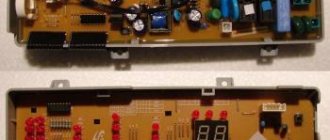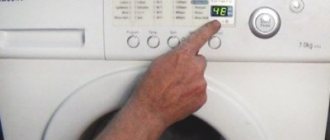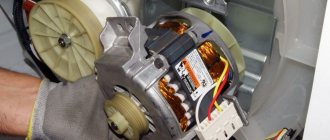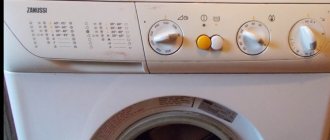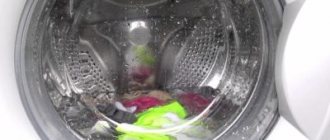You loaded the laundry, set the desired program, and the washing machine began to fill with water. In the first minutes, everything was going normally, but at some point it became clear that the collection of water did not stop at the right moment, and there was a lot of water in the drum.
Note! In some cases, its level can even rise to half the tank.
After this, the drain pump turned on, the water that entered the drum went into the sewer, and the machine stopped washing and displayed an error message in the form of a message on the display or a combination of flashing indicators. If this happened to your washing machine, then you are faced with an overflow of water into the machine.
Attention! Do not confuse overflow with a similar problem where the washing machine constantly fills with water. In this case, the normal amount of water is poured into the drum, it is simply drained at the same time, so the machine is forced to constantly add water. The execution of the program may not stop until the owner stops the machine manually. If your machine constantly takes on water, read another article.
How to determine if there is a malfunction
If the flow of water does not stop after the tank is full, this usually leads to the following consequences:
- Water injection continues. The tank is more than half full.
- The water level sensor detects that there is too much water and gives a command to drain it.
- The drain pump starts working and eventually only laundry remains in the tank.
- Then an emergency stop of the washing machine occurs due to the inability to continue working.
The following situation should not be confused with the situation described here:
- There is a constant injection of water;
- At the same time, pumping works.
At the same time, the liquid level in the tank remains within normal limits.
How dangerous is water overflow in a washing machine?
Many non-professionals who do not understand the structure of washing machines “scare” users with the dire consequences of overflowing. They say there is a high risk of flooding your neighbors or flooding the electronic control unit of the car itself. In fact, most modern washing machines have built-in overfill protection. As soon as the water level in the tank reaches a critical level, the overfill protection is triggered, the water is drained, and the device displays an error message. The risk of flooding your neighbors or damaging the electronic components of the device itself exists only in very old automatic machines, mostly domestically produced.
The reason why a washing machine overflows water, according to the experience of the RemBytTech workshop, most often lies in a breakdown. Only in rare cases can the problem be fixed on your own.
What you can do yourself
If such a problem occurs, there is a possibility that it is a random hardware failure. To check this, you need to turn off the washing machine, wait a few minutes and turn it on again.
If the uncontrolled collection of water continues, it is necessary to turn off the machine and drain the collected water. The latter can be done using standard means by clicking on the corresponding button on the control panel. If this cannot be done, you can use a hose for emergency draining.
Major breakdowns associated with overflow
If you can't figure out why your washing machine is taking in a lot of water, check out the following reasons for the problem:
- The pressure switch tube is clogged, disconnected or damaged. In this case, the machine overflows water, then drains it and stops working. Depending on the cause of the breakdown, you will need to clean, replace or replace the tube.
- The water level sensor chamber is dirty. It can become clogged not only with dirt, but also with scale. Repairing a washing machine will involve dismantling and cleaning the device.
- The pressure switch itself broke. The problem can only be solved by replacing the part.
- The control module, which sends a signal to stop the flow of water, has failed. If the board cannot be repaired, it will need to be replaced.
- The fill valve is broken. With such a breakdown, the washing machine pours a lot of water immediately after starting washing or rinsing. Then the liquid is drained, but the SM does not turn off. She continues to work and continue to collect water. The unit can only be repaired by replacing the valve.
If the equipment overflows water, it needs to be repaired urgently. This should be done not because you risk flooding your neighbors. This risk is minimal if other components of the machine are in good working order. You will simply waste water and powder, which will immediately go down the drain at the very beginning of the wash. Therefore, do not use a broken SM and do not try to fix it yourself to avoid unnecessary complications. It’s better to call our service center and call a specialist to diagnose and repair washing machines.
If you are energetic, responsible, independent!
If you have experience in repairing household or industrial appliances, then join the strongest league of professionals in your field! Call or send your resume.
Types of breakdowns
If restarting does not fix the problem, then we are talking about a malfunction of one of the components of the washing machine. The most common reasons are related to malfunctions of the level sensor. This happens in 90% of cases.
The level sensor does not have the ability to determine the water level directly. Since the washing machine tank rotates during operation, the amount of water is determined using pressure measurements.
This sensor is called a pressure switch. When a sufficient volume of water accumulates in the drum, it is triggered and further flow is blocked.
For example, contacts in it can burn and oxidize. Sometimes failure to operate occurs because the membrane has lost its seal. Only a technician can determine why the problem occurred.
Sometimes the problem is caused by particles of rust or debris entering the valve along with water from the water supply. However, other reasons are also possible.
The following describes in detail what needs to be done in various cases.
In case of excessive intake and complete drainage of water
In this situation, excessive water enters the drum and is completely drained. In some cases, the machine gives a signal indicating a breakdown.
There could be several reasons:
- The problem is due to a faulty pressure switch sensor tube. It may have become loose, damaged, or clogged. In this case, it is possible to carry out repairs yourself, eliminating the cause of the breakdown. The valve continues to operate normally.
- When the pressure switch chamber became clogged with debris. If you clean it, the machine will work normally.
- If the sensor that detects the water level fails. In this situation, you need to contact specialists for repairs.
- Sometimes the reason that the washing machine takes in a lot of water and does not wash is a non-functioning control device. If you contact the service department, such a breakdown will be corrected.
Water is gathering and it doesn’t stop
If the sensor does not respond and water flows in, then the most likely cause is a faulty fill valve. In a situation where it is jammed, it cannot shut off the water.
This valve is an electronic device. When voltage is applied to it, it opens and water begins to flow into the washer from the water supply. When the pressure switch (level sensor) determines that the machine is ready for washing, the fill valve is de-energized and the flow stops. If normal operation is disrupted, it does not stop the flow of water. In this case, the built-in protection will not work and water may spill out due to a faulty valve. This may cause damage to electronic components exposed to water.
In order to cope with this problem, it may be necessary to replace the valve.
Incorrect connection when installing the machine
If during installation the drain hose is not installed in the loops provided for it on the body, then water will flow uncontrollably through the drain hose into the sewer. In this case, the washer will constantly not have enough water. This will cause a lot of water from the mains to flow through the inlet hose and inlet valve.
Because of this, additional loss of washing powder will occur. Because the water actually becomes running due to constantly open valves, the machine does not heat the water to the optimal temperature for washing.
Usually this reason occurs during the first time after purchasing and installing the washing machine.
To check what is causing the problem, you need to do the following check:
- You need to start the car.
- When the water has completely filled, you need to turn on the drain.
- While it continues, you need to press pause and see what happens.
If the drain continues after stopping, this indicates an incorrect connection. Otherwise, the problem is a breakdown of one of the components or sensors of the machine.
Damage to the inlet (fill) valve
When diagnostics show that the pressure switch and associated parts are working properly, the cause of the uncontrolled drainage of water may lie in a malfunction of the inlet valve. Due to prolonged use, the valve's membrane may weaken, which leads to liquid leakage even when it is closed. Also, the valve may fail and not shut off the water at all. In this case, a situation similar to an incorrectly connected machine is repeated - the water from the tank is constantly decreasing, as a result of which the pressure switch gives constant signals about the need to fill the tank and the circle is closed.
Another sign of incorrect operation of the inlet valve is the situation when, even when turned off, the machine continues to draw water.
To eliminate the malfunction, the inlet valve must be replaced. Most front-loading washing machines have the inlet valve located at the rear of the unit near the top lid. You can access the part by removing the top cover. For machines with a vertical loading type, the valve should be looked for in the basement area - in the lower part of the rear wall. By separating the side wall you can gain access to the valve.
To replace this part, turn off the water and disconnect the inlet hose from the washing machine. The next step is to separate the wires leading to the valve and the hoses from its fittings. If possible, you can replace the disposable clamps installed there with worm clamps. After this, you need to unscrew the fastening screws with which the valve is fixed to the body of the washing machine. Some machine models provide for fastening the valve using a latch. You can remove the valve by retracting the latch tab and turning the valve body to the desired position. After this, the part can be removed without any hindrance. Install the new part in the reverse order.
If you are unable to resolve the problem yourself
The owner of a washing machine can practically only make sure that the problem when the washing machine takes in too much water is not an accidental failure of the control system. If the malfunction of the machine is definitely established, it would be a reasonable decision to call a technician from the service department.
He will be able to determine the breakdown only after inspecting the car. After the water is drained from the washer, he will have to disassemble it. He will need to inspect the sensors, the intake valve. After analyzing the situation, he will decide what repairs are needed in this situation.
Its cost should include the cost of work and the price of those components and parts that will have to be replaced. It is best to contact those specialists who will not only fix the breakdown, but also provide a guarantee.
Electronics malfunction
If the washer constantly fills with water even after replacing the valve and pressure switch, then the problem is in the control module.
A malfunction of the main unit leads to the fact that the working sensors of the machine cannot cope with their functions, as they receive incorrect signals from the control board.
The control unit may fail due to:
- voltage drops in the network;
- water ingress;
- mechanical impact;
- end of the standard service life.
In this case, the control board cannot be repaired. It is recommended to invite a specialist and replace the unit with a new one. There is no point in delaying solving the problem; the sooner the problem is fixed, the fewer “sacrifices” you will be able to make.
Interesting:
- Dishwasher malfunctions
- Bosch dishwasher errors
- Water flows from below under the Atlant washing machine
- Malfunctions of Hotpoint Ariston washing machines
- What is “Pre-wash” in a washing machine
- The Indesit washing machine constantly fills with water
Reader comments
- Share your opinion - leave a comment
